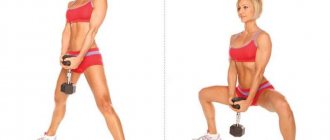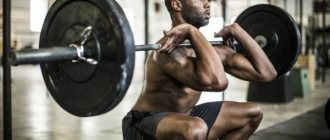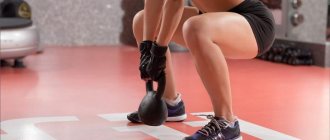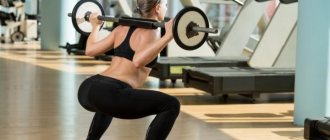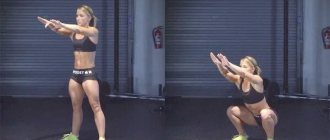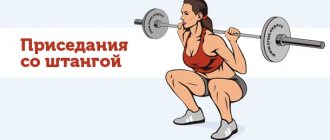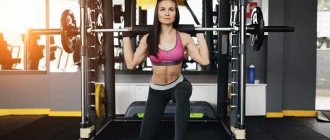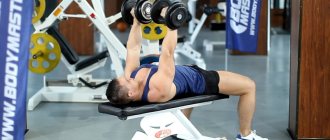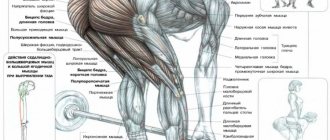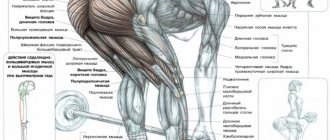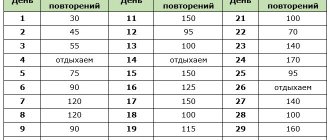Share:
What you need
- dumbbells
Every athlete or coach will agree that squats with dumbbells are a necessary exercise for gaining muscle mass. It is hardly possible to do without it. This is a basic multi-joint movement in which a huge number of muscle groups are directly or indirectly involved. And without a base there will be no growth.
You need to train your legs regularly, regardless of your sports goals. One workout per week will be enough. If it is physically and psychologically difficult for you to work out this entire muscle mass at one time, you can do quadriceps and hamstrings on different days. If you are gaining muscle mass, muscular legs will make your figure more proportional.
Moreover, heavy load on large muscle groups (and legs are such) promotes increased production of endogenous testosterone, which stimulates muscle growth and an increase in strength.
In this article we will look at how to do squats with dumbbells correctly, what are their benefits and what types of this exercise exist.
Benefits of Exercise
Let's start with what exactly the exercise is useful for athletes and what are its advantages over squats with a barbell.
- When working with dumbbells, it is easier for you to vary the angle of the load. For example, you can place your feet wide or narrow, place one foot on a bench, lift dumbbells above your head, etc. This way you can modify the load, shifting the emphasis to the quadriceps, buttocks, hamstrings or hip adductors. This is much more difficult to do with a barbell and requires experience and coordination.
- It will be easier for you to keep your back straight and squat deeper. This is the main advantage of squats with dumbbells for girls - the greater the amplitude, the more the gluteal muscles are involved, and this is the goal of most female athletes.
- The next important factor is mental attitude. Your brain perceives dumbbell squats as an easier exercise than barbell squats. Therefore, the body does not need any additional stimulation. If you are a fan of heavy training and squat almost record-breaking weights every week, vary your workouts. Do squats with dumbbells at least once a month. This way you will relieve your central nervous system a little from constantly working at the limit and protect yourself from overtraining.
- Another advantage of squats with dumbbells is that you can do them not only in the gym, but also at home. All you need is a pair of collapsible dumbbells. Do several sets of dumbbell squats with different leg positions, Bulgarian squats, lunges, straight-legged deadlifts, calf raises, and you’ll get a full-fledged volumetric leg workout.
Varieties
There are several options for performing squats. All of them are quite effective, so it’s worth familiarizing yourself with each of them. The most popular exercise options:
Front squat. This exercise is a squat with dumbbells on your shoulders. The technique is simple, similar to squats with a barbell. It is necessary to take the starting position, lift the dumbbells, bend your arms at the elbows, and partially transfer the weight to your shoulders. After this, perform a squat, pausing a little at the bottom point, and return to the starting position. Plie. This is a unique type of deep squat with dumbbells, in which the greatest load is placed on the adductor muscles of the thigh. The starting position will differ from the classic version: your feet should be placed wider than your shoulders, your toes should be spread to the sides. In this case, you must hold the dumbbell with both hands in front of you by one of the heads. To perform the plie, stand in the starting position, then squat deeply, keeping your back straight. The legs should be spread as far as possible, the thighs should be parallel to the floor. Return to starting position. Squats with one dumbbell overhead. Starting position - feet shoulder-width apart, sports equipment is held with both hands (usually bent at the elbows). By distributing the load, such a squat with dumbbells overhead helps to effectively work out the buttocks. To perform it correctly, you need to take the starting position, straighten your back, squat, lingering at the extreme point for a few seconds. The back remains straight and the hips should be horizontal. Return to starting position. Scissor squats. Another type of effective leg exercise with dumbbells for men and women. Sometimes they are called “lunges in place” due to the similarity of execution. This exercise works the front and inner thighs. Starting position - standing, one leg extended forward, the other back, arms extended down to the sides. To perform “scissors” with dumbbells, you need to do a squat with your knees bent. In this case, the thigh of the front leg and the shin of the back leg should be parallel to the floor. Squats with press. When training your legs with dumbbells, you can also give a load to your arms (biceps, triceps) and shoulders (deltoids and trapezius muscles). Squats with presses are a great way to combine work on different parts of the body. You need to take the starting position (it is the same as for front squats), squat down, while doing a dumbbell press up
It is important to stay for a few seconds at the extreme point. After this, you can return to the starting position.
"Scissors"
With a bench press
Plie
Frontal
With dumbbells overhead
Benefits of squats
Squats with dumbbells involve a huge number of stabilizer muscles. In this case, these are the deltoid and trapezius muscles, spinal extensors, core muscles, calf muscles, neck muscles, biceps and many others. Do you understand how much load you set with just one exercise?
In addition to stabilizer muscles, ligaments and tendons are also strengthened. You become stronger and more resilient with every workout.
Squats with dumbbells place less axial load on the spine. This does not mean that it is not there at all, and if you have hernias and protrusions, you can do them every workout. Not at all. Simply working with dumbbells in a gentle manner will not aggravate existing problems, unlike barbell squats.
In addition, working with dumbbells is much more mobile. You can place dumbbells on racks and immediately pick up a lighter or heavier pair. It is much more convenient to perform dropsets, supersets and giant sets. All of these techniques for increasing intensity contribute to greater overall results.
Contraindications
Not all athletes will benefit from this exercise. If you have knee problems, you need to perform squats very carefully, work with light weights and strictly follow the correct technique. A thorough warm-up and use of knee bandages is also necessary. This applies not only to dumbbell squats, but also barbell squats, leg presses, lunges and other leg exercises.
It is not recommended to perform this exercise if you have problems with the spine. We are not talking about mild scoliosis or lordosis, but about serious hernias and protrusions in the thoracic or lumbar regions, when any forceful load is contraindicated. If such problems do not bother you, you can safely perform squats with dumbbells.
What muscles work?
Depending on where exactly you place the dumbbells, what incline you hold, how wide you place your legs, and how you place your feet, you can focus the load on the quadriceps, glutes, hamstrings, or hip adductors.
For example, when doing plie squats with a dumbbell, we spread our legs wider than shoulder-width apart and turn our feet outward, and keep our body strictly vertical. This loads the inner thigh and buttocks, part of the load is taken by the quadriceps. It's the same story with wide squats with dumbbells. Such a load makes the hips larger. The inner surface of the thigh responds well to load in almost all athletes; with the outer surface, everything is much more complicated, and few even experienced athletes can boast of its development.
To develop the outer quadriceps, close-legged squats, overhead dumbbell squats, or single-leg dumbbell squats are more suitable. It is important to place your feet parallel to each other to further contract the lateral quadriceps muscle.
You can also shift the load specifically to the gluteal muscles. Bulgarian squats with dumbbells are best suited for this. The load falls almost exclusively on the buttocks; if you lean forward a little more, the hamstrings will also begin to work. The greater the amplitude in these movements, the better. Deep squats with dumbbells are great for girls.
Which muscles get the load?
Let's find out which muscles work in squats with dumbbells; by the way, it depends on the position in which the apparatus is held. The tilt of the body, the placement of the feet, the turn of the toes, and the depth of the squat are also important. So, what muscles are worked by dumbbell squats?
- Inner thigh;
- External thigh muscles;
- Gluteus maximus and gluteus medius muscles;
- Quadriceps;
- Biceps;
- Calf muscles;
- Back and abdominal muscles.
Sounds good, doesn't it?
General principles of the exercise
Next we will talk about several variations of the exercise, but before moving on to a description of the technique of each type, we should mention the general principles of correct squats with dumbbells.
- Working out the inner thighs is facilitated by wide stance of the legs and turning the toes outward (more than 45 degrees).
- Working out the gluteal muscles is facilitated by the maximum possible range of motion (below the level of parallel with the floor).
- Working out the outer thigh is facilitated by a narrow and parallel stance of the legs.
- Working out the hamstrings is facilitated by a slight bend forward and moving the buttocks back during movement.
Features of their use
Before we talk about the types of squats with dumbbells, as well as the correct technique, here are some general nuances:
- If your goal is to target the inner thigh muscles, stand with your feet wider than shoulder-width apart and turn your toes out more than 45 degrees;
- If you are trying to pump up your buttocks, squat as deep as possible;
- If you want to pay attention to the outer thighs, place your feet parallel and close to each other;
- In order for the hamstrings to work, you should tilt your body forward in a squat and move your pelvis back;
- During any squats, keep your back straight without rounding your spine;
- In all exercises, you should ensure that your heels do not leave the floor. The exception is at the top of the lift - here you can rise on your toes to engage the calf muscles.
Types of squats with dumbbells
Let's look at several of the most effective types of squats with dumbbells.
Plie squats with dumbbells
Plie squats with dumbbells - to perform effectively, you need to hold it with both hands in front of you at waist level. Instead of a dumbbell, you can also use a kettlebell or a barbell disc. The main thing in this exercise is to maintain the correct body position.
- The dumbbell should not weigh you down or tilt you down.
- We place our feet wider than our shoulders, turn our toes outward, the angle is approximately 60 degrees.
- Keep your back strictly vertical.
It is advisable to place your feet on step platforms; this will increase the range of movement by a few precious centimeters, and you will be able to go lower. Due to this, the buttocks and hip adductors will work harder. You need to lower yourself down until you touch the back of your thigh to your calf muscles. The pace of the exercise is smooth; no sudden movements should be made. It is important to feel the stretching and contraction of the muscles at each point of the amplitude.
Bulgarian squats
The next popular leg exercise that can be performed with dumbbells is Bulgarian squats. To perform them you will need a horizontal bench. We place one foot on the bench with the toe down, and bring the other forward. The distance between the legs should not be too large; the front leg should be slightly bent at the knee. Squat down smoothly on your front leg. Anatomically, the movement is similar to lunges. The farther you place the front leg, the more the gluteal muscles work; the closer, the more the load is emphasized on the quadriceps. Beginner fitness enthusiasts are advised to adhere to a certain “golden mean”: put one leg forward so that the knee remains slightly bent, and there are still a few centimeters between the knee and the foot.
If you want to additionally “hook” the inner surface of the thigh, do not place your front leg straight, but slightly turn your toe outward. The exercise should be done with moderate weight; in no case should you round the thoracic spine when lowering down. The amplitude here may be somewhat shortened. Often athletes work in a static-dynamic mode, without going all the way down and without straightening the knee at the top point. This way, the necessary muscle group will be under constant tension, and even light dumbbells will be enough to create sufficient prerequisites for muscle growth.
Squats with dumbbells on shoulders
Squats with dumbbells on the shoulders almost completely imitate classic squats with a barbell. The load vector falls in exactly the same way. The only difference is that there is no need to statically tense almost all the muscles of the torso, as with heavy squats with a barbell. Just position the dumbbells so that you are comfortable without them weighing you down. Keep your back as straight as possible so as not to place stress on the spinal extensors.
© artinspiring — stock.adobe.com
Another option for holding dumbbells on your shoulders:
© dusanpetkovic1 — stock.adobe.com
Deep squats with dumbbells in hands
You can load the quadriceps in isolation by performing deep squats with dumbbells in your hands. The easiest way to do this is to use one dumbbell or kettlebell and hold it in front of you at chest level. The result will be an almost complete imitation of front squats with a barbell. This exercise is often called goblet squats.
Here it is advisable to use a relatively narrow parallel position of the legs. Place your feet slightly narrower than shoulder-width apart so that you can comfortably perform the exercise with a decent weight and you can fully focus on contracting your quadriceps. At the bottom point, you can take a short pause, completely extinguish the inertia and rise upward in an explosive manner. This training method develops explosive strength and speed of movement well. In the same style, you can perform squats with dumbbells in your hands, keeping your arms straight along your body. This exercise is good for developing neuromuscular communication and teaches you better control of the stabilizer muscles, which will be useful for you on record weights in barbell squats.
Single leg dumbbell squats
For experienced athletes, squats with dumbbells on one leg are also good. This exercise requires not only strength, but also tremendous coordination and balance. It should be performed at a slow pace and with light working weights. Of course, before this you need to learn how to consistently perform pistol squats without additional weight, or at least with the help of TRX loops or other support.
© Makatserchyk — stock.adobe.com
Overhead dumbbell squats
CrossFit athletes can take note of an exercise such as overhead squats with dumbbells. It is not much different from overhead squats with a barbell in terms of biomechanics, but psychologically it is much easier. These exercises are needed in order to increase your results in basic weightlifting movements: snatch, clean and jerk, clean and others. Here you can give yourself free rein and work with heavy weights, but remember that the correct technique for performing the exercise is above all.
© Arsenii — stock.adobe.com
Alternatively, you can perform this variation of the movement with two dumbbells:
Scissor squats with dumbbells
Dumbbell scissor squats are a variation of lunges. They are especially popular among girls. They are done in exactly the same way as Bulgarian squats, only without using a bench. To increase the range of movement, you can place one or two step platforms under your front leg. This way you can go down as low as possible and fully bend your front leg at the knee joint. This way the quadriceps will do more work than when performing movements at half the amplitude.
Popular variations
When including this exercise in their training, many do not stop at one type of squat. This is the right decision, because variety of activities makes training more effective. Let's look at various variations of this exercise that will help work the muscles from all sides.
Sumo with dumbbells
Sumo with one weight is ideal for those who want to shape their hips and add definition to their buttocks. It's done like this:
- spread your legs wide to the maximum, straighten your back, and place the dumbbell in front of you, clasping it with both hands;
- start squatting slowly until your thighs are parallel to the surface;
- press your heels to the floor, try not to bend your back;
- in the indicated position, freeze for a few seconds and return to the starting point.
Plie squat
Good for working the legs, done as follows:
- clasp one dumbbell with both hands, feet wider than shoulder-width apart, with your toes turned ideally 45 degrees;
- inhale and squat low enough, with your back straight;
- freeze at the bottom for a couple of moments, and then exhale sharply and rise up.
Bulgarian squat with weights
A very effective training for the legs, but you will need a bench to perform it. The technique is as follows:
- stand next to the bench, place dumbbells in your hands;
- place one foot on the bench, and the other should be 15 degrees in front of the body;
- lower yourself smoothly so that the thigh and floor are like two parallels, and the knee of the free leg should be in contact with the floor;
- keep your body straight.
Don’t forget to change legs; another name for this variation is split, and the advantage of it is that it allows you to give some muscles of the body a rest.
Squats with dumbbells on shoulders
- Starting position standing with dumbbells facing your hips.
- We lift them onto the biceps, then throw them over the shoulders and firmly fix them in the upper position, placing them vertically on the shoulder joint.
- We do a slow squat, concentrating on the leg muscles. Controlling balance.
- We slowly rise, returning to the starting position.
This exercise may not be suitable for everyone. If you have problems with your elbow joints, you may experience pain under heavy weights, so choose an appropriate weight or avoid this type of squats altogether. You can also replace it with the following exercise.
Squat with dumbbells overhead
This exercise is more suitable for security forces. It additionally helps strengthen the muscles of the arms, back and shoulders. It is performed like the previous one, the only difference is that during the upward movement you need to additionally lift the dumbbells above your head, straining your back and controlling your balance.
Features of execution:
- When squatting, lean on your full foot - this will give additional control of balance when lifting.
- Do not throw the projectile suddenly upward to avoid injury.
- Do not lean your body forward too much, otherwise you will fall.
- Watch your breathing.
Basic exercise technique
So, we briefly examined the main types of squats with dumbbells. The same technical principles apply to all of them:
- We use moderate weight dumbbells. Do you want to set records? Place them in barbell squats. We need squats with dumbbells in order to relieve the psyche a little from heavy weights, diversify the training process and give the muscles an unusual load to which they are not yet adapted. Also, many powerlifters use them as an aid to classic squats, and this bears fruit.
- In all exercises you need to keep your back straight. Rounding the spine is unacceptable; this can result in serious injury. At the starting point, stand straight, look forward or slightly upward (this will make it easier for you to get up from the lowest point). We bring the chest forward and up. The downward movement is carried out while inhaling, it is advisable to do it slowly to feel how the muscles stretch.
- Squats should be deep. It is advisable to squat below parallel. Ideally, your buttocks almost reach the floor. This requires good coordination and flexibility. Additionally, hone these skills, then any exercise will be much easier.
- At the lowest point, the knee should not go forward beyond the level of the toe. This is the golden rule of any type of squat.
- The positive phase of the amplitude passes approximately twice as fast as the negative one. We always get up while exhaling. If you do not follow the correct breathing sequence, by the end of the set your blood pressure will rise, and it will take at least a couple of minutes to regain your breathing.
- The most important thing when standing up is to keep your knee in the correct position. It should be located in the same plane as the foot. Do not wrap it inward under any circumstances; it is very easy to injure the knee ligaments this way. A slight outward movement of the knee is acceptable, but it is better not to do this either, as this will make it more difficult for you to concentrate on the work of the leg muscles.
- The pause at the top should not be too long. Firstly, the axial load on the spine at this moment is maximum. Secondly, when you just stand straight with your knees straight, the muscles are in a relaxed state. Pumping is much more difficult to achieve this way. It is advisable not to pause at the top point at all or not to fully extend the knee in order to maintain constant tension in the muscles.
- If you perform squats with dumbbells with straight arms, use wrist straps if necessary. This will take your mind off the grip and allow you to fully focus on your quadriceps.
- Always warm up and stretch thoroughly before performing dumbbell squats. This way you are guaranteed to protect yourself from injury.
Analysis of the exercise
Dumbbell squats are a lighter alternative to basic squats using a barbell, which also allows you to effectively work the muscles of the thighs and buttocks. The distribution of the workload in the context of individual muscle groups occurs in the exercise as follows:
Among the amateur audience, squats with dumbbells in hands are considered a traditional “girly” exercise; the male half of trainees more often prefer to use the traditional modification of the movement with a barbell. Mainly for the sole reason that more weight can be used in the classic barbell squat.
Meanwhile, there are no useless movements in strength disciplines: changing the usual equipment allows you to diversify the training program of an experienced athlete, safely learn the technique of the main movement and prepare the muscles for increasing working weights. And the squat with dumbbells may be the only alternative to the classic exercise for an athlete with back injuries.
The classic version of the “dumbbell” squat involves holding the weight in outstretched arms on both sides of the body. It is more convenient from the point of view of maintaining balance, and therefore is the most exploited.
Preparing for Squats
Start preparing to perform squats with a general warm-up and light aerobics (you can “ride” an exercise bike or jog on a treadmill). Next, proceed to a targeted warm-up - perform 1-2 “light” sets of bodyweight exercises for 10-20 repetitions.
How to squat with dumbbells correctly
The main points on technique in squats with dumbbells and a barbell are identical:
- Make it a rule: your knees are always directed towards your toes. Sometimes cramping of the knees signals that the inner heads of the quadriceps are lagging behind in development. In this case, additionally include exercises in your training to strengthen them.
- Raising on your toes while sitting down shifts the load on the knee joint and makes it difficult to maintain a balanced body position. Correct execution of “dumbbell” squats involves standing on the entire foot with the load transferred to the back part of it (the heel). If your heels regularly lift off the floor, it is recommended to place discs under them.
- When bringing the knees forward, beyond the toe line, the joints take on a large share of the load. When performing technically, the kneecaps should be in the projection of the foot.
- Strive to keep your back in a position close to vertical - this allows you to accumulate the load in the quadriceps, without transferring it to your back.
- The back should remain straight, with a slight anatomical curve in the lumbar spine (lordosis).
- At the top of the movement, a slight angle is maintained in the knees, which allows you to maintain the load in the target muscles and not load the joint.
- Correct and safe performance of squats with dumbbells involves monitoring your breathing technique: inhale when lifting, exhale when lowering into a squat.
Errors
Performance Recommendations
Inclusion in the program
The “introduction” of an exercise into a strength program depends on the training “context” in which it is intended to be used. Squats with dumbbells in your hands, performed to pre-exhaust the target muscles or warm them up, can open up your leg workout. But with the same success it can also “crown” the complex if, after performing exercises with a barbell, you need to additionally “finish off” the working groups.
In both cases, it makes sense to perform the dumbbell squat at a high volume – 12-15 repetitions in 3-5 approaches. When solving specific problems, such as weight loss, the numerical parameters of the training are subject to adjustment in the direction of increasing the number of repetitions. The weight load also changes in proportion to the volume of work.
A beginner should always start with light weights and increase them only with impeccable technique. When this goal is achieved, adhere to the principle of progressive load and increase the intensity of work
Contraindications for implementation
Dumbbell squats are a safe option for training target muscles compared to the basic “barbell” squat, since they significantly reduce the axial load on the spine. However, this exercise should still be included with caution in the training program for athletes with serious injuries to the knee joints, osteochondrosis (sciatica) or “fresh” vertebral hernias. Performing exercises with large weights is contraindicated if there is damage to the wrist joints.
